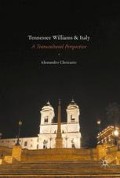Abstract
Previously unpublished censorship documents show how Tennessee Williams was literally under surveillance in the early 1950s. Elia Kazan’s film version of A Streetcar Named Desire won two prizes at the Venice Film Festival but had to wait for almost three years before being allowed distribution. In the meanwhile, Warner Bros suggested a whitewashing of the character of Blanche in order not to alert censors. For moral (and political reasons) a magazine of the Catholic Church deemed the film good as a “lesson” on the dangers of sin. The chapter goes on to analyze all the major productions of Un tram che si chiama desiderio in Italy on the background of the changing aesthetic and dramatic canons.
Access this chapter
Tax calculation will be finalised at checkout
Purchases are for personal use only
Works Cited
Argentieri, Mino. 1974. La censura nel cinema italiano. Roma: Editori Riuniti.
Bologna, Patrizia. 2012. Un tram che si chiama desiderio. Emilia Romagna Teatro Fondazione. (Playbill).
Brancati, Vitaliano. 1952. Ritorno alla censura. Bari: Laterza.
Bruno, Eduardo. 1951. Un tram che si chiama desiderio. Filmcritica 8 (September): 98–99.
Casiraghi, Ugo. 1951. Alice aprirà il sipario sulla Venezia del cinema. L’Unità, August 19, 3.
Cesarale, Sandra. 2001. Provocatorio e ‘soap’ il tram tedesco di Tennessee Williams. Il Corriere della sera, October 31, 59.
Cibotto, G. A. 1973. Suo regno, la disperazione. Il Gazzettino, February 10, 3.
Clericuzio, Alessandro. 2014. Tennessee Williams’ Ladies Speak Italian. Voice Transculturation on Stage and in Dubbing. In Tennessee Williams and Europe: Intercultural Encounters, Transatlantic Exchanges, ed. John S. Bak, 147–163. New York and Amsterdam: Rodopi.
Colomba, Sergio. 2012. Il capolinea di Blanche. Il Resto del Carlino, February 23, 32.
Compagnone, Sandro. 2001. Brividi sulle punte. La Repubblica, November 29, 29.
De Monticelli, Roberto. 1978. Un Tram sovraccarico di simboli. Il Corriere della Sera, November 2, 19.
Di Giammarco, Rodolfo. 2000. Quel tram sulla via della folle brutalità. La Repubblica, August 7, 36.
———. 2001. Viaggio nell’Est. Ultima fermata l’America. La Repubblica, October 30, 10–11.
———. 2012. Dimenticare Marlon, il Tram non è desiderio. La Repubblica, March 4, 54–55.
Domani al Moderno un ‘Tram’ tutto nuovo. 2012. Corriere di Maremma, April 3, 13.
E. P. 1972. Sul ‘tram’ di Williams non c’è posto per la speranza. La Nazione, December 12, 15.
Fenin, Giorgio N. 1952. Il cinema americano nel 1951. Bianco e nero 1 (January): 52–59.
Fiore, Enrico. 1995. La Bovary fra i berberi. Il Mattino, March 9, 14.
Forgacs, David, and Stephen Gundle. 2007. Mass Culture and Italian Society from Fascism to the Cold War. Bloomington: Indiana University Press.
Francia, Silvia. 2000. Salto sul primo Tram. Mi sembra di sognare. La Stampa, July 28, 32.
Giani, Renato. 1952. Il verismo e il realismo del cinema americano. Bianco e nero 11 (January): 57–65.
Grazzini, Valentina. 2012. Laura Marinoni: ‘La mia Blanche è la metafora del teatro’. L’Unità, April 1, 13.
Gromo, Mario. 1951. Un tram che si chiama desiderio. La Stampa, September 11, 3.
Marinucci, Vinicio. 1951. Non arriva al cinema il tram che si chiama desiderio. Momento, September 10, 11.
Melchiori, Giorgio. 1954. Le raffinatezze della violenza. Lo spettatore italiano, May, 274–275.
Gli Orgogliosi. 1954. Rivista del Cinematografo, 6, June, 25.
Palazzi, Renato. 2012. Il treno è più bello smontato. Il Sole 24 Ore, February 26, 46.
Poli, Magda. 2002. Brava la Quattrini nel Tram di Williams. Il Corriere della sera, March 9, 61.
———. 2012. Se il destino è cadere nella solitudine. Il Corriere della sera, April 8, 39.
Possenti, Eligio. 1955. Un tram che si chiama desiderio. Corriere della sera, July 8, 4.
Prosperi, Giorgio. 1973. Un tram che si chiama desiderio conserva intatti tutti i suoi valori. Il Tempo, February 15, 10.
———. 1978. Riciclato Il tram di Williams e spostato dal Sud a New York. Il Tempo, December 8, 10.
Quadri, Franco. 1993. Quel tram si chiama ancora desiderio. La Repubblica, July 4, 37.
R. N. 1972. La fermata del tram. La Notte, December 21, 11.
Raboni, Giovanni. 1993. Tram del desiderio fuori orario. Corriere della sera, July 4, 20.
Rea, Domenico. 1979. Commedia con eroi stanchi. Il Mattino 11 (January): 14.
Sanguineti, Tatti. 2014. Giulio Andreotti. Il cinema visto da vicino. (A documentary film). Istituto Luce Cinecittà.
Savioli, Aggeo. 1993. Il tram di Williams non ferma più qui. L’Unità, July 4, 21.
Solmi, Angelo. 1954. Un tram con molti simboli. Oggi, May 13, 38.
Stefanile, Mario. 1973. Un tram chiamato desiderio. Il Mattino, March 22, 11.
Tian, Renzo. 1978. Un vecchio tram preso per la coda. Il Messaggero, December 8, 13.
Un tram che si chiama desiderio. 1954. Rivista del Cinematografo 6 (June): 24.
Vice. 1972. (Signed as “V”). ‘Tram’ al San Babila. Il Corriere della sera, November 21, 15.
———. 1973. Un tram che si chiama desiderio. Il Messaggero, February 15, 9.
Viganò, Aldo. 1994. Nel franto mondo, il rito. In Tennessee Williams. Un tram che si chiama desiderio,195–205. Genova: Marietti.
Vigorelli, Giancarlo. 1978. Un tram torna dall’inferno. Il Giorno, December 24, 15.
Author information
Authors and Affiliations
Rights and permissions
Copyright information
© 2016 The Author(s)
About this chapter
Cite this chapter
Clericuzio, A. (2016). More Streetcars: The Screen and the Stage. In: Tennessee Williams and Italy. Palgrave Macmillan, Cham. https://doi.org/10.1007/978-3-319-31927-8_4
Download citation
DOI: https://doi.org/10.1007/978-3-319-31927-8_4
Published:
Publisher Name: Palgrave Macmillan, Cham
Print ISBN: 978-3-319-31926-1
Online ISBN: 978-3-319-31927-8
eBook Packages: Literature, Cultural and Media StudiesLiterature, Cultural and Media Studies (R0)

